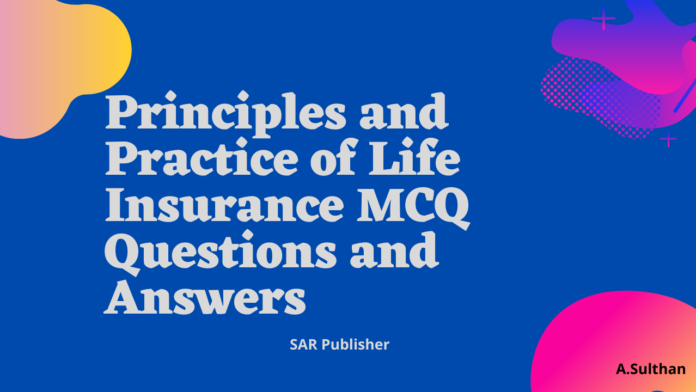Principles and Practice of Life Insurance MCQ Questions and Answers Part – 1
Principles and Practice of Life Insurance MCQ Questions and Answers Part – 2
Principles and Practice of Life Insurance MCQ Questions and Answers Part – 3
101. What is a proposal?.
A. A request for an insurance cover.
B. An offer to enter into a contract.
C. Both a request and an offer to enter an insurance contract.
D. None of the above.
ANSWER: C
102. If the premium was due on 15th July and 16 August is a Sunday.
A. the grace period will end on 14th august (Friday).
B. the grace period will end on 15th august (Saturday).
C. the grace period will end on 17th august (Monday).
D. the grace period will end as per the discretion of the insurer.
ANSWER: C
103. A policy which has been assigned, will revert to the assignor.
A. if the assignor survives till maturity.
B. whenever the assignor demands it.
C. when the conditions specified in a conditional assignment happen.
D. on maturity of the policy.
ANSWER: C
104. In life insurance, profit is determined by____________.
A. the accountant who prepares the balance sheet.
B. the actuary who makes a valuation.
C. the auditor who certifies the annual accounts.
D. the third party.
ANSWER: B
105. A plan of insurance is said to be different from another if __________.
A. the sum assured is different.
B. the age of the life to be insured is different.
C. the date of commencement of policy is different.
D. the conditions when the sum assured becomes payable are different.
ANSWER: D
106. Who is benefited if a policy is under the salary savings scheme?
A. The policyholder.
B. The insurer.
C. The agent.
D. All the three above.
ANSWER: D
107. Which of these persons will not be given a license to work as an insurance agent?
A. A person with criminal record.
B. A corporate insurance executive.
C. An employee of an insurance company.
D. All the three mentioned above.
ANSWER: A
108. A type of insurance contract through which protection is given against loss of crop from risk is known as ______.
A. Fire insurance.
B. Crop insurance.
C. Marine insurance.
D. Automobile insurance.
ANSWER: B
109. A memorandum added to a policy embodying some alterations to the terms of policy is known as ___________.
A. Endorsement.
B. Discharge of contract.
C. Breach of contract.
D. Nomination.
ANSWER: A
110. A kind of insurance which provides for indemnity for loss against health such as loss of time and medical expenses due to sickness is called _________.
A. Fidelity insurance.
B. Crop insurance.
C. Health insurance.
D. Fire insurance.
ANSWER: C
111. Insurer is a person who has ______.
A. insured his life or goods.
B. helped a person to get an insurance policy.
C. undertaken to make good the loss of the subject matter of insurance.
D. file a suit in a court of law to recover an insurance claim.
ANSWER: C
112. Average clause is a fire policy_________________.
A. average the claim on the different policies taken by the insured.
B. insures the property at average premium paid for the class three years.
C. insures the property at the average rate of premium recovered during the last year only.
D. penalizes under-insurance.
ANSWER: D
113. In which of the following types of insurance should insurable interest be present only at the time when policy is taken?
A. Fire insurance.
B. Life insurance.
C. Marine insurance.
D. Life and marine insurance.
ANSWER: B
114. Paid-up value is payable on a life insurance policy________.
A. on the maturity of the policy.
B. when the policy lapses.
C. when the policy is surrendered.
D. on maturity or death whichever is earlier.
ANSWER: D
115. Insurance technique is based on the principle of __________.
A. pooling system.
B. compensating others.
C. helping others.
D. Indemnity.
ANSWER: A
116. A person insured his goods worth Rs. 2000 for Rs. 1600 and suffers a loss of Rs. 1800. His claim can be for__________.
A. Rs. 2000.
B. Rs. 1800.
C. Rs. 1600.
D. Rs. 3800.
ANSWER: C
117. The principle of contribution applies when_____________.
A. the full amount of premium is not applied by the insured.
B. there are two or more insurance on the risk.
C. the insured insures the same risk policy with other insurers.
D. the insured insures the same risk policy with different persons.
ANSWER: B
118. The principle of _______ does not apply to life insurance.
A. Subrogation.
B. utmost good faith.
C. Contribution.
D. Indemnity.
ANSWER: D
119. Main emphasis of risk management is on ____________.
A. risk retention.
B. reduction of cost of handling risk.
C. risk transfer.
D. Insurance.
ANSWER: B
120. The IRDA has replaced ___________.
A. the controller of insurance.
B. the LIC chairman.
C. department of insurance.
D. department of commerce.
ANSWER: A
121. Which of the following is the similarity between insurance and gambling?.
A. The amount of loss to be paid is known before hand.
B. Promise to pay on the happening of an event.
C. Both the parties win on happening of an event.
D. Both are enforceable at law.
ANSWER: A
122. The concept of insurance is__________.
A. to make money out of death.
B. to earn interest.
C. to earn a status.
D. to share losses by many.
ANSWER: D
123. A human life is an income-generating asset___________.
A. partially true.
B. partially false.
C. True.
D. False.
ANSWER: C
124. The company doing the insurance business is called _________.
A. mutual funds.
B. non-banking firm.
C. banking company.
D. an insurance company.
ANSWER: D
125. Which one of the following comes under miscellaneous insurance?.
A. Marine insurance.
B. Motor insurance.
C. Fire insurance.
D. Group insurance.
ANSWER: B
126. Which of the following is an evidence of insurance contract?
A. Insurance Policy
B. payment of premium.
C. cover note.
D. acceptance of proposal.
ANSWER: A
127. Term assurance provides the following benefits _________.
A. death benefits if the person dies within term.
B. death and survival benefits.
C. periodic payments at predictable intervals.
D. death benefits with bonus.
ANSWER: A
128. Which of the following is a children policy of LIC?.
A. Jeevan Sneha.
B. Jeevan Vishwas.
C. Jeevan Dhara.
D. Jeevan Sukanya.
ANSWER: D
129. The premium is lowest for ____________.
A. money back policy.
B. term insurance.
C. whole life policy.
D. endowment policy.
ANSWER: C
130. Annuity plan offer _______________.
A. Liquidity.
B. capital appreciation.
C. Profitability.
D. regular assured return.
ANSWER: A
131. Claim is processed on the basis of ___________.
A. claim form and agents opinion.
B. legal opinion.
C. claim form, survey report etc., other documents and any evidence secured by the insurer.
D. survey report.
ANSWER: C
132. Insurance writing is often referred to as ___________.
A. rate making.
B. Underwriting.
C. Undertaking.
D. Documenting.
ANSWER: B
133. As per the Principle of Insurable interest, it should be present in the case of life Insurance _________.
A. at the time of claim settlement.
B. at the time of survival only.
C. only at the inception of the policy.
D. at inception and at the time of revival.
ANSWER: D
134. European started the Oriental Life Insurance Company in Kolkata in the year ________.
A. 1870.
B. 1872.
C. 1818.
D. 1906.
ANSWER: B
135. The first Indian Insurance Act was passed in __________.
A. 1938.
B. 1985.
C. 1912.
D. 1956.
ANSWER: C
136. The concept of bancassurance originated in ___________.
A. France.
B. U.S.A.
C. England.
D. Italy.
ANSWER: A
137. The clause which sets out the essence of the contract is ______________.
A. The Preamble.
B. Recital Clause.
C. Conditions.
D. Operative Clause.
ANSWER: D
138. Cargo Ship Caught by fire is an example of __________.
A. particular average loss
B. General average loss
C. constructive total loss
D. Actual total loss
ANSWER: B
139. Corpus fund is created with contributions from the Central Government and State Government on
________________.
A. 50:50
B. 60:40
C. 70:30
D. 75:25
ANSWER: A
140. The danger of loss from the unforeseen circumstances in future refers to __________.
A. Perils
B. Hazard
C. Damage
D. Risk
ANSWER: D
141. Committee of Reforms in insurance sectors during 1993 headed by ________.
A. S. Narashiman
B. Manmohan Singh
C. R.N. Malhotra
D. P. Chidamabaram
ANSWER: C
142. The proportion of the risk which the direct insurer holds on his own account refers to ___________.
A. Line.
B. Retention
C. Retrocession
D. Ceding insurer
ANSWER: B
143. When the same risk and subject matter is insured with more than one insurer is called as_______.
A. Double insurance
B. . Over insurance
C. Reinsurance
D. External insurance
ANSWER: A
144. When the amount for which a subject matter is insured is more than its actual value is called __________.
A. Double insurance
B. Over insurance
C. Reinsurance.
D. Crop insurance
ANSWER: B
145. When was IRDA Act passed?
A. 1930
B. 1956
C. 1972
D. 1999
ANSWER: D
146. There are ___ subsidiary companies available.
A. 2
B. 3 .
C. 5
D. 4
ANSWER: D
147. ___ is the first insurance company to transact the general insurance business
A. Trition Insurance
B. LIC.
C. GIC
D. None of the above
ANSWER: A
148. Oil well liability covers
A. Scalling operations
B. Drilling operations
C. Machinery Operations
D. None of these
ANSWER: B
149. Poultry Insurance covers
A. Species of Birds
B. Reared of Eggs
C. Meats of Feathers
D. All the above
ANSWER: D
150. Credit Insurance Covers
A. Coverage against bad debts
B. Coverage against fire loss
C. Coverage against Marine loss
D. Coverage against burglary
ANSWER: A


